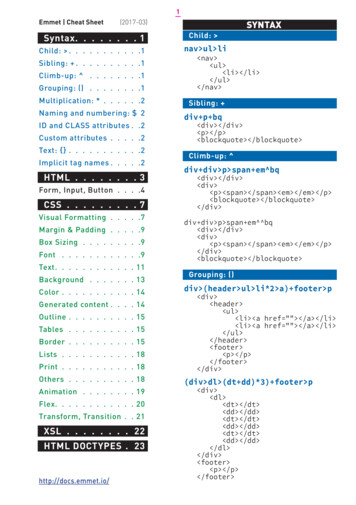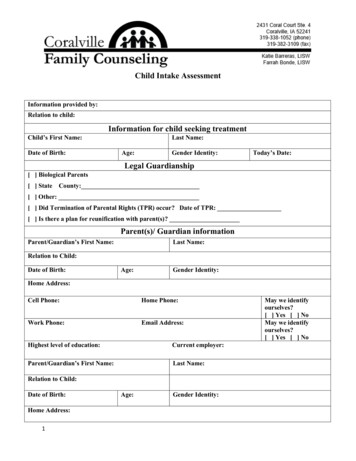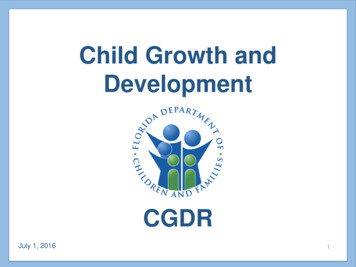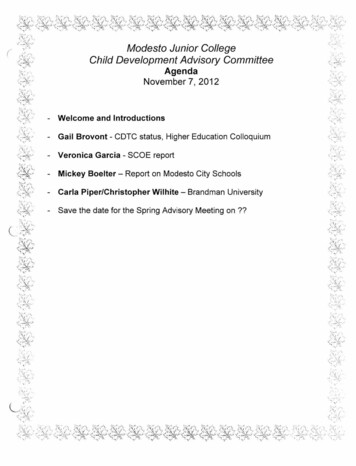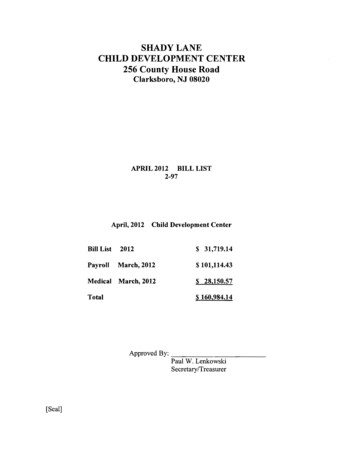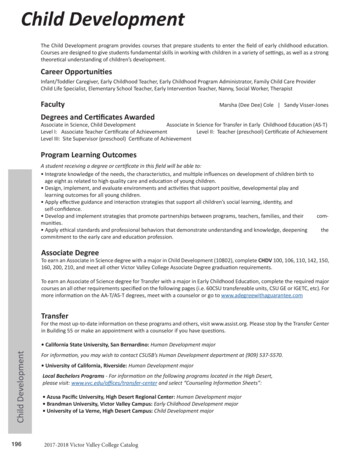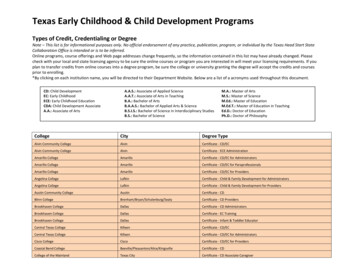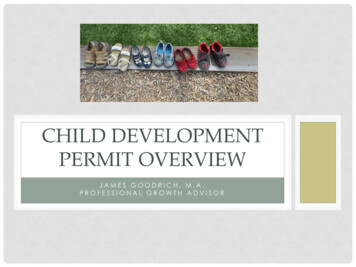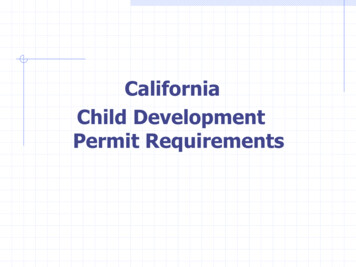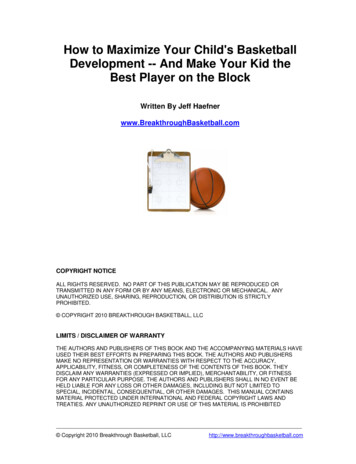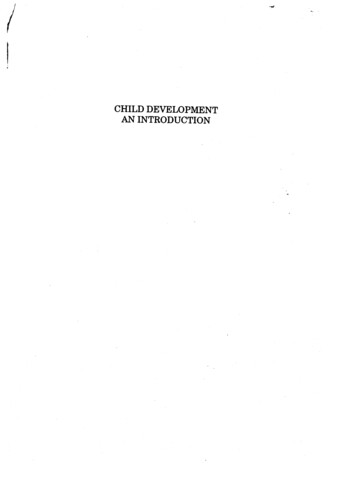
Transcription
CHILD DEVELOPMENTAN INTRODUCTION
ENCYCLOPAEDIA OF CHILD AND FAMILY WELFARE SERIESCHILD DEVELOPMENTAN INTRODUCTIONEditor-in-ChiefLAXMI DEWINSTITUTE FOR SUSTAINABLE DEVELOPMENTLUCKNOW&ANMOL PUBLICATIONS PVT. LTD.'NEW DELHI-hO 002 (INDIA)
ANMOL PUBLICATIONS PVT. LTD.4374/4B, Ansãri Road, DaryaganjNew Delhi-hO 0027IkMembers of Editorial BoardLaxmi Devi, Member Secretary, ISDDr. Mukta Mittal, Director, ISV (Lucknow Hqs.)Dr. Arun Kumar, Director of ISD, (Bihar Branch)Mr. Ajay Kumar, Executive Member, ISVMr. Bibhuti Yadav, Executive Member, ISDMr. Arvind Kumar, Executive Member, ISDMr. Kashi Yadav, Director, ISDJ\,Child Development: An IntroductionCopyright Institute for Sustainable DevelopmentFirst Edition 1998ISBN 81-7488-926-4be reproduced, stored in a retrieval system or[All rights reserved. No part of this publication mayrecording or otherwise,transmitted, in any form or by any means, mechanical, photocopying,without prior written permission of the publisher.JPRINTED IN INDIANew Delhi-hO 002 and PrintedPublished by J. L. Kumar for Anmol Publications Pvt. Ltd.,at Mehra Offset Press, Delhi.
ContentsPreface1. Theories of Child Developmentvii12. Child Development Theoretical and Conceptual Issues3. Growth and Development of Children4. Stages and Principles of Child Development5. An Introduction to Principles and Practice6. Aspects of Development7. Genetics8. From Conception To Birth9. The Body Develops10. Basic Factors in Development of Child11. The Developing Child12. The Newborn Infant13. Physical Growth and Development14. Physical and Motor Development15. Motor Development16273160707682919711113714015116016. Motor Development in Children17. The Brain Develops16617418. Language Development19. Language Development in Children20. A Functional Approach to LangUage Development183193203
vi21. Social Development21222. Social Development in Children22023. Socialisation24. Emotional Development23025. Emotional Development in Children29326. Emotions and Motivation30227. Moral Development31328. Cognitive Development29. Scientific Study of Behaviour and Development31930. The Development of Human Understanding339253334
PrefaceChildren are an end and means of progress. It is high time to attend the needs and rights ofchildren not as "a mere by-product of progress but as an end and means of progress itself."Millions of children the world over are growing up in circumstances under which they will neverbe able to fulfil the mental and physical potential with which they are born. This is a humantragedy which contains within itself the seeds of its own renewal is imperative tobreak the selfperpetuating cycle which is central to development process. Without this all other investmentin food production, Community Services and Human Resource Development will be lesseffective because a significant proportion of people neither be able to contribute fully to themnor benefit fully from them. According to UNICEF's report the two tests of civilization is howwell, it protects vulnerable and how well it safeguards its future; Children are both vulnerableand its future.Children are backbone of a Nation. On their health and prosperity depends the health of aNation. India has the second largest child population in the World. Therefore, planning for childdevelopment needs special care and falls in the category of target based planning. Itis to beviewed in totality-as a part of national social well-being. India is a developing country and quiteseeable section of its population suffers from he problem of poverty, inadequate sanitation, substandard housing, malnutrition and lack of education. Thus the development of the children inthis country will basically depend on overall development of the society and people of thiscountry. The problem of child welfare thus can not be viewed in isolation.In the earlier days child care services were confined to the voluntary sector. These serviceswere mainly organised for victims of destitution, delinquency, abuse, etc. In mid-twenties,voluntary organisations such as Indian Council for Child Welfare, the Indian Red Cross Society,the All India Women's Conference, the Kasturba Gandhi National Memorial Trust, the BalikajiBan, the Children's Aid Society, etc. organised programmes in the area of care, health nutritionand education for children.The primary institutions of the society such as family and in most cases, the joint family hadbeen the responsibility of child care. The child's physical, psychological, social and cognitivedevelopment was assured by the resources and the surrounding of the joint family. Thetransition from joint to nuclear family and changes in socio-economic status have brought manychanges in society. Because of the new constraints, traditional care suffered progressiveerosions. Child neglect, abuse and exploitation followed.
(viii)Several disciplines are involved in understanding the growth and development of thisvulnerable group. By its very nature, therefore, this is an inter-disciplinary area of knowledgeand work. Social workers and educationists have been for a long time concerned more with childdevelopment and have contributed a great deal in focussing the attention of the people to theimportance of several factors which should be taken care in helping children to develop fully.Considerable public opinion and the pressure of interested groups have led towards greaterinvestment of public funds as well as private funds for the cause of development of children.It is however, necessary to understand the scientific basis of child development so that publicopinion can be more informed and teachers, social workers and specialists can really contributein a larger measure towards adequate attention of children in our country.In view of this the present encyclopaedia encompasses a wide range of contents andapproaches in its ambit and, as such it is expected to be of much interest to a vast spectrum ofscholars. This Encyclopaedia is designed for use of neo-leamer and divided into following sixvolumes: 1. Child Development: An Introduction; 2. Health, Nutrition and Early ChildhoodEducation; 3. Policies and Programmes related to Child Development; 4. Child Labour; 5. SocialAttitude Towards Children; and 6. Child and Family Welfare.A number of colleagues and friends have provided valuable advice and assistance, hencewe shall be failing in our duty if we do not express our gratitude to them. Finally we are indebtedto Shri J. L. Kumar, Managing Directoi, Anmol Publications Pvt. Ltd., New Delhi for bringingout this work in a very short duration.Laxmi DeviI
1Theories of Child DevelopmentThe Nature of Theories in Science and in Child DevelopmentIt can be argued that we do not need a theory of child development since everything can beexplained by common sense. Indeed, there are some who dismiss all psychology as common sensedressed up in statistics. But one need consider only the history of opinions on the shape of the worldto be made wary of common sense. For thousands of years it was self-evident that the world is flat;just look and you will see. A proper wariness of the self-evident has led to the development of theoriesin natural science based on two major features:1. Hypotheses must be testable: A statement must be capable of disproof if it is to be incorporatedinto a scientific system. Thus I can say that my Aunt Mabel is a bad cook. This statementcan be tested by getting her to cook several dishes and trying them out. In theory it wouldbe possible to imagine her producing a stunning meal which would show me to be wrong.On the other hand, if I were to say that my Aunt Mabel will never win the football polls Icannot devise an experiment that will show this to be wrong because one day she may win.A popular saying, 'The exception proves the rule', is actually a shortened version of themore correct 'The possibility of an exception supports the rule'.2. Observed phenomena must be repeatable: Anyone carrying out research in the natural sciencesmust describe the work so that another person may repeat it and thus verif' it. Behind thisinsistence on repeatability is a search for general laws leading to experiments that can becarried out at will. To take an example: there is mild interest in the story of someone whohas a dream about another person who subsequently dies; there would be tremendous scientificinterest in anyone who could have such a dream repeatedly. Scientific laws might be generatedif the dreams could be experienced on command.Is a Science of Child Development Possible?The answer to this question is a qualified 'yes'. One can certainly make coherent statements whichare testable. It is possible to carry out experiments or other investigations in a way that enables othersto repeat them. But there are some aspects of child psychology and therefore of child development
Child Development An Intmductionwhich are less suitable for this rigorous approach. The work of the psychoanalytic school of psychology,discussed below, is seen by some commentators as falling outside the boundaries of science because somany of its statements are untestable.Even if untestable theories are rejected one is left with a choice between several others. The wouldbe scientist has two choices open: either to select from the range of alternatives that which seen themost plausible and most far reaching in its application and to reject all others, or to take here and therefrom several, selecting those aspects of theories that seem most helpful. In either case it will be necessaryto become aquainted with as many approaches as possible.Why have a Theory?At this point the reader may wonder why theorising is necessary. Why do we not collect andrecord observations rather in the same way that we collect stamps. We can then watch our collectionof observations grow richer and richer. Without a theoretical backing to one's observations there is nocoherence to the thoughts that arise. The stamp collection analogy is not quite irrelevant: consider howmuch difference there is between a collection of stamps put into a book haphazardly and one with thesame stamps arranged first by country and then by set.The Nature of a Theory of Child DevelopmentFirst an acceptable theory must provide explanations for events. A logical problem can arise indistinguishing between explanations and descriptions. For example, one might consider a table of wordacquisition as a function of the child's age. Does such a table explain or simply describe how manywords a child is likely to have at a give age ? In general such distinctions are rarely marie—moreimportant is the second point of whether of not a theory can accurately predict.The predictive power of a theory is seen by some as central. Prediction here is not related toforetelling the future in a crystal ball sense: it means using observable data within a framework of atheory to predict the occurrence of other observable phenomena. For example, take a three-year- oldchild who has never before been parted from his mother and watch as he becomes an in-patient in ahospital which restricts visiting. Our observed data are related to his age and experience. Usingattachment theory one can predict that he will be upset by this experience and will show signs ofdistress. This prediction can be checked. It is not likely to be confirmed in every single case becausehumans are so complex that few if any such predictions are 100 per cent correct. Rather, though, wecan speak of probabilities of the prediction's validity.A theory becomes more powerful when it predicts what is not already known to be true, when itgenerates predictions rather than merely confirms them. Piagetian theory, for example, allows us togenerate many hypotheses about children's ability to learn.Third, a theory must use clear language. Only if the basic theory is clearly expressed can onecarry out experiments to test what is said. Clarity of language leads to operation definitions, operationalhere meaning that the definition is sufficiently clear that one investigator knows exactly what anothermeant. It is no use describing a child as 'fretful' unless one says what signs are to be observed in afretful child.
Theories of Child Development3Fourth, the theoiy must be capable of disproof This point about testable hypotheses has alreadybeen noted above, and it applies as much to child development as to any other field if the theory is toregard itself as scientific.Pre-Twentleth-Century Concepts of Child Development and Contributions to TheoryScience as we know it today expanded during the nineteenth century. Before then most conceptsabout children were derived from religious teaching. Little thought was expended on wondering whychildren behaved in a certain way, much more went on working out ways of disciplining them andmoulding their characters. Lloyd de Mauser, in The History of Childhood (Souvenir Press, 1974), states(some would say overstates) the case thus:'The history of childhood is a nightmare from which we have only recently begun to awaken. Thefurther back in history one goes the lower the level of childhood and the more likely children are to bekilled, abandoned, beaten, terrorised and sexually abused.'But eventually thoughts did turn to topics related to how children do grow up rather than howthey should. A major contribution to the field was made by Lambert Quetelet, a Belgian mathematician-astronomer who published On Men and the Development of His Faculties in 1859, a book that socaught the public imagination that it sold out in one day. Darwin's work, plus that of Gregor Mendel,paved the way for the consideration of humans as influenced both by environment and heredity—twotheoretical standpoints which seem set to continue generating research for evermore.An offshoot of Darwinian theory was a view, particularly popular during the nineteenth century,that ontogeny recapitulates phylogeny—that is, the development of an individual repeats the stages ofthe evolution of the species. Some evidence was given to support this view by observations that thehuman foetus does appear to develop much as other mammals but the whole nation of recapitulation isnow seen as a gross oversimplification. Few psychologists today would agree with early theorists thatchildren should, in order to be well-adjusted later, go through animal-like stages of behaviour whenvery young.Towards the end of the nineteenth century Francis Galton, sometimes known as the first Britishdevelopment psychologist, supervised measurements of nearly 10,000 visitors to the 1884 LondonExposition. To manipulate these data Galton developed a number of statistical techniques, includingthat of correlation.By the end of the nineteenth century the field was set, with tools available, for the explosion oftheory that has taken place since then. Four major theories are considered in some detail in the nextsection.Assimilation is used to describe how the organism can handle new problems with existingmechanisms.Accommodation is the process by which the organism changes in order to handle new problemswhich the existing system cannot manage.The two should be seen as complementary processes.At a more complex level one can consider the sequence of the two. A.L. Baldwin gives an examplein his Theories of Child Development (John Wiley, 1967), a book from which I have drawn heavily in
4Child Development An Introductionthe writing of this chapter. His example is of the schema of grasping. An eight-month-old child will beable to grasp certain objects, say a finger, but not something very small or very large. The gradualacquisition of the ability to grasp other-sized objects can be seen as an example of accommodation.But before accommodation can take place the object must in some sense seem to be graspable, i.e. Theschema must to some degree assimilate the object before accommodation occurs. Since this process isso central to Piaget's work and since it often provides a stumbling block to students of his work, itwill be approached more descriptively, as shown in Fig 1.1A new situationactivates the relevant schemaIf the schema can copeIf the schema cannot copethe new situation is dealt with,i.e. it is assimilated and thechild goes on to something else.the new situation is partiallyassimilated but brings with ita challenge, i.e. the schemamust accommodate.The schema accommodates andequilibrium returns with thenew situation assimilated.The child goes on tosomething else.Fig. 1.1 The process of accommodation.The model shown in Fig. I can go some way to explaining motivation: if something is either tooeasy or so difficult that there is no possibility of accommodation the organism will give up. What isrequired is that the new situation is sufficiently recognisable to allow some initial assimilation but alsosufficiently novel to maximise accommodation. It is reasoning of this kind that has led Piaget's workto have such an impact on educational theory.Stages of development play an important part in Piagetian theory which deals in some detail withthe way in which he sees a child's understanding passing through certain stages. Here it should benoted that while Piaget perceived development as being continuous, this does not imply that there is asimple, linear path from the neonate to the fully mature. Rather certain structures underly behaviour at
Theories of Child Development5certain times, so one may assert that a child is at a certain stage according to what he is capable of atthat time. These structures are developed in sequence, each building on the one that went before.Sigmund FreudEveryone has heard of Piaget but most people cannot understand him; everyone has also heard ofFreud but most do not believe him. This is a somewhat flippant but not totally untrue statement, for noother theorist on child development can have met the same degree of disbelief becoming hostility thatFreud encountered. In his History of the Psychoanalytic Movement Freud himself noted how a formercolleague (Breuer) '.showed the reaction of distaste and repudiation which was later to become sofamiliar to me, but which at that time I had not yet learned to recognise as my inevitable fate'.Sigmund Freud (1856-1939) was born in Moravia, now in Czechoslovakia, then part of the AustroHungarian Empire, the first-born son of a superstitious mother who saw the fact that he entered theworld covered in a growth of black hair as a portent that he would become a great man. Freud himselfwas aware of the influence that his mother's faith in his greatness had: 'A man who has been theundisputed favourite of the mother keeps for life the feeling of a conqueror.'His father, however, was less indulgent. Previously married, financially insecure, he was stern,insisting that the traditional Jewish injunction about honouring the father be obeyed.The young Sigmund intended to be a lawyer but found himself with what he later described as anurgent necessity to understand something of the riddles of this world. So he chose the path of scienceand after a diversion into physiology finally qualified in medicine in Vienna in 1881. After a spell inneurology he moved to the study of nervous diseases, then in its infancy, and went to Paris where hestudied under the greatest psychiatrist of the time, Jean Marie Charcot. Charcot had made hypnotism arespectable practice, at least in some circles, and used it to investigate hysteria, long thought to be theresult of a malfunctioning uterus. When Freud returned to Vienna and spoke of men suffering fromhysteria he met immediate opposition and then, having demonstrated that such a possibility was to beobserved, he was ignored.Finding that hypnosis was not always adequate for his needs, he developed the technique of freeassociation to uncover thoughts. He became even more isolated from respectable scientific circles bythe publication of his theories of sexuality which he derived from what his patients said when in acompletely relaxed state.By 1902, however, he had gained sufficient acceptance to enable him to become the centre of asmall group of doctors and writers including Alfred Adler and Wilhelm Stekel. Professionally he was'professor extraordinary' at the university in Vienna, a post given for his earlier work in neurology, farfrom the recognition that some have seen in it. But he and his circle continued in their assertion thatthere was more to medicine than the body. The First World War marked a rough dividing line inFreud's work, for it was in the post-war years that he devoted himself to theoretical formulations andtheir application to society as a whole.Such was their success that psychoanalytic notions and vocabulary began to permeate the thinkingof the western world. In 1929 he was granted the freedom of Vienna and on his seventy-fifth birthdayhe was made an honorary member of the Vienna Medical Society. He received these and other honourswith little enthusiasm, attending none of the celebrations and accepting nothing in person.
Child Development: An IntroductionIn 1938 he left Vienna for London. The Nazis had burned his books five years earlier but they lethim go on payment of a quarter of a million Austrian schillings. In London he soon settled to a regularwork routine, including seeing patients, but in 1939 he succumbed to the cancer which had afflictedhim for sixteen years. He died of cancer of the mouth, greatly exacerbated if not caused by excessivesmoking. He fitted neatly into his own formulation of an 'oral' personality: ambitious, envious, with atendency to self-punishment.Psychoanalytic Theory: Basic PrinciplesThe central assumption of psychoanalytic theory is that much of what we do is governed by forcesburied in our unconscious. The forces are conceptualised as being like physical energy which comefrom the primitive part of our personality and have to be expressed somehow. The process of socialisationleads to a need to repress or to channel these forces and the way this is done leads to personalityformation. Problems of anxiety and neurosis can be traced to conflicts between the forces which needexpression and the more policeman-like part which forbids this expression.A further assumption is that all behaviour can be explained in this way—we never do anything byaccident. Thus when we are late for an appointment we do not, at some level, really want to keep it;when we say something which is apparently a slip of the tongue we really do mean to say what wedid. The phrase 'Freudian slip' comes from this notion. (See Freud's The Psychopathology of EverydayLfè, 1901).Much of psychoanalytic writing is concerned with treatment. This will largely be ignored in thefollowing part of this chapter not because it is not important to the theory but because it is not centralto an understanding of the theory's explanation of child development.Instinctual DrivesOne of the fundamental concepts of psychoanalytic thought is the instinctual drive, not to beconfused with instinct in the sense that it is used in, for example, nest-building in birds. Drives in thepsychoanalytic sense are seen to be the root of an almost limitless variety of human behaviour.The assumed mechanism is thus: instinctual energy is psychological energy. As energy becomesaccumulated in specific areas of the body, organs become tense; when the tension increases the energybreaks through as a desire—to eat, scratch, drink or have sex. Gratification occurs when the desire ismet, the origin of the whole process being the paramount need to maintain life. Unfortunately Freudused terms like 'sexual' or 'erotic' to cover such pleasurable gratification, which leads to muchmisunderstanding of his basic point.Libido is a word that exemplifies both much of his thought and much of misunderstanding. 'I givethe name of libido to the energy of the sexual instincts and to that form of energy alone,' he wrote.But he also wrote that he saw sexuality as 'divorced from its too close connection with the genitals.asa more comprehensive bodily function having pleasure as its goal and only secondarily coming toserve the ends of reproduction'. He went on to note that the term also covered 'all those merelyaffectionate and friendly impulses to which usage applies the exceedingly ambiguous word love'.Nevertheless, it is hardly surprising that some of his ideas related to libido shocked the good
Theories of Child Development7doctors of Vienna. It must have been difficult for them to contemplate the notion that little boys areafraid that their fathers will castrate them or that farming is a symbolic rape of the mother.Ego instincts is a term covering a number of other drives seen as less important than the libidinal.They included hunger, thirst and the escape from pain.As with the theories of others, that of Freud was not static and he revised ideas on instinctivedrives. Later on in his life, in 1920, he speculated on whether or not one could tracethem all to a fewbasics. After what he described as 'long hesitancies' he concluded that all could be reduced to two:Eros, or the life instinct, and its counterpart, Thanatos, the death instinct. The latter was an inevitablepart of the theory for if he was asserting that all behaviour is explicable is was essential that he invokesome mechanism to account for suicide, masochism and self-destructive acts.Cathexis is the notion which links the instinctual drive to actual behaviour. Once onehas conceivedof a drive almost as though it were physical energy then that energy can be attached in varying quantitiesto different objects, people and ideas: this particular form of attachment is called cathexis. One canobserve a child and his mother and see how important she is to him; one can then argue that for himshe is cathected. An important corollary to this idea is that the greater the cathexis in any one directionthe less there is to go round to others. A child who remains fixated on his mother is unlikely ever toreach sexual maturity.The UnconsciousConsciousness defined by David Stafford Clark as '. an immediate, constantly changing reflectionof everything of which we are aware at a given instant in time', was seen by Freud as no more than arelatvely small part of an individual's mental life.Preconsciousness is the storehouse of memory: everything that is available to us when we try torecall.The unconscious contains both the more primitive drives and impulses influencing our behaviourwithout our ever being aware of their influence, plus every set of idea or memories which have astrong emotional charge and which have been repressed so that they are no longer available to theconscious process. It is important to avoid falling into the trap of thinking that unconscious refers onlyto that of which we are unaware; by definition it is referring to that of which we cannotbe aware.The Id, the Ego and the SuperegoFreud saw the development of socialisation from child to adult not in terms of different instinctualdrives or even different amounts of drives but in the pattern of cathexis or other regulating mechanisms,which determine how those drives are satisfied. The pattern of cathexis he described in three moretermscalled1. The id. To understand the concept of the id one must first be aware of what Freuditnowandheis notprimary process. The young child knows what he wants and he wantsprepared to wait and no matter how often he is told that he cannot have it he will stamp hisfeet and have a tantrum because he wants it now and he really does not care what otherpeople think about him. This is primary process functioning and it governs one structure ofthe personality known as the id.
Child Development : An IntroductionAnother way of characterising the id is to see it as governed by the pleasureprinciple: onlyimmediate pleasure, which can include relief from pain, is taken into account. It is no usetelling a young child that treatment in the dentist's chair will lead to less pain in the future:what counts is the pain the dentist is inflicting now this minute.2. The ego is the second system to develop within the child's personality system. The id remainswithin the unconscious; the ego is that part of the unconscious which has been separated inorder to make contact with the external world. Above all else, the ego is realistic, it delaysand inhibits drives, representing the role of enlightened self-interest. Gratification is still thegoal, but gratification gained in a more mature way than is found if one follows only the id,for the ego is capable of delaying gratification to make it the greater.3. The superego is a rather different matter. There is no direct conflict between the id and theego, they differ only on how to attain their ends. The superego, on the other hand, hassomewhat different aims.The superego is that part of the personality which restricts totally rather than modif'ing the drivesof the id. Freud saw the superego as playing a policeman-like role, acting to serve the good of societyas a whole by curbing the self-seeking energy of the other two aspects. Freud emphatically did not,however, see the superego as being culturally determined, no matter what its function. Rather, he sawthe child develop a superego as he interpreted parental injunctions on sexuality. In this way therestrictions imposed by a superego may be out of all proportion violent and extreme. In such cases theego can be seen as an intermediaiy between the id and the superego.The Freudian Theory of PsychodynamicsThe concepts given above form the bricks of Freudian theory; they operate together in apsychodynamic system.A cornerstone to the theory at work is that action is controlled by consciousness. Thus althoughmuch may come from the unconscious it can never directly influence behaviour. A crucial area ofstudy then is the conditions which detemine access to consciousness.One condition is that the nature of consciousness is such
1. Theories of Child Development vii 1 2. Child Development Theoretical and Conceptual Issues 16 3. Growth and Development of Children 27 4. Stages and Principles of Child Development 31 5. An Introduction to Principles and Practice 60 6. Aspects of Development 7. Genetics 70 76 8. From Con

